
Original Link: https://www.anandtech.com/show/2396
NVIDIA GeForce 8800 GTS 512 & GeForce 8800 GT 256MB: Playing with Memory and G92
by Anand Lal Shimpi on December 11, 2007 12:00 AM EST- Posted in
- GPUs
Generally, you don't see many products released in December. It's getting a little too late to make dramatic impacts on Q4 earnings as many have already done their holiday shopping. If a company is going to release a new product this late in the year, there's generally a good reason for it, or it's simply a product we'll never see.
At the end of October NVIDIA introduced its GeForce 8800 GT, based on a brand new 65nm GPU codenamed G92. The 8800 GT quickly outclassed virtually every NVIDIA GPU, making most of the G80 lineup obsolete by offering better performance at lower prices. A higher end incarnation of the 8800 GT's G92 was inevitable, we just didn't expect to see it this soon.
The GPU is the same, we're still looking at a G92 derivative part, but the card is all new: the GeForce 8800 GTS 512.


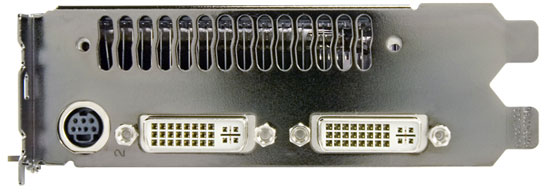
A dual-slot G92, the larger heatsink keeps this card a bit cooler than the 8800 GT but with no increase in sound
While NVIDIA is in a better position than AMD is these days, NV marketing could stand to learn from AMD's recent changes. The Radeon HD 3800 series carry no tacky suffixes, just four digit model numbers to keep things nice and simple. Not only is the GeForce 8800 GTS 512 absurdly long, it also further complicates the 8800 product line. If you'll remember back to our 8800 GT review, the 8800 GT is faster than the old G80 based 8800 GTS. The new 8800 GTS 512 is faster than the 8800 GT, and thus faster than both the 320MB and 640MB versions of the old GTS. So you end up with the following lineup today:
8800 Ultra > 8800 GTS 512 > 8800 GTX > 8800 GT > 8800 GTS 640 > 8800 GTS 320
Confusing to say the least, but if you can forget about all of the other products on the market you'll see that there are only two NVIDIA cards to be concerned with: the 8800 GTS 512 and the 8800 GT.
| Form Factor | 8800 Ultra | 8800 GTX | 8800 GTS | 8800 GTS 512 | 8800 GT 256MB | 8800 GT | 8600 GTS |
| Stream Processors | 128 | 128 | 96 | 128 | 112 | 112 | 32 |
| Texture Address / Filtering | 32 / 64 | 32 / 64 | 24 / 48 | 64 / 64 | 56 / 56 | 56 / 56 | 16 / 16 |
| ROPs | 24 | 24 | 20 | 16 | 16 | 16 | 8 |
| Core Clock | 612MHz | 575MHz | 500MHz | 650MHz | 600MHz+ | 600MHz+ | 675MHz |
| Shader Clock | 1.5GHz | 1.35GHz | 1.2GHz | 1.625GHz | 1.5GHz+ | 1.5GHz+ | 1.45GHz |
| Memory Clock | 1.8GHz | 1.8GHz | 1.6GHz | 1.94GHz | 1.4GHz - 1.6GHz | 1.8GHz |
2.0GHz |
| Memory Bus Width | 384-bit | 384-bit | 320-bit | 256-bit | 256-bit | 256-bit | 128-bit |
| Frame Buffer | 768MB | 768MB | 640MB / 320MB | 512MB | 256MB | 512MB | 256MB |
| Transistor Count | 681M | 681M | 681M | 754M | 754M | 754M | 289M |
| Manufacturing Process | TSMC 90nm | TSMC 90nm | TSMC 90nm | TSMC 65nm | TSMC 65nm | TSMC 65nm | TSMC 80nm |
| Price Point | $600 - $800+ | $500 - $600 | $270 - $450 | $349+ | $219 - $229 | $299 - $349 | $140 - $199 |
Architecturally, the 8800 GTS 512 adds another group of 16 shader processors over the 8800 GT. We'd suspect that the 8800 GT has the same number of SPs, but with one block of 16 disabled to increase yields.
Since it's based on G92 we get a 1:1 ratio between texture address and texture filtering, giving the GTS 512 the first leg up over the much more expensive 8800 Ultra. With a 650MHz core clock and 1.625GHz shader clock, the GTS 512 has an 8% shader processing advantage over the Ultra.
The only area where the 8800 GTS 512 loses to the 8800 Ultra is in its total memory bandwidth. The 8800 Ultra, like the 8800 GTX, features a 384-bit wide memory bus while the GTS 512 uses the same 256-bit memory interface from the 8800 GT. There are definite cost advantages to going with a 256-bit memory bus; NVIDIA can build a smaller chip with fewer pins, and make up for the loss in memory bandwidth by shipping the card with faster memory devices. Despite the 1.94GHz memory data rate on the 8800 GTS 512, the 8800 Ultra and GTX have around a 40% memory bandwidth advantage, resulting in better performance in memory bandwidth limited scenarios and high resolution AA tests.
Despite being built on a 754M transistor die, the move to 65nm has made G92 much smaller and thus cheaper to make than G80, which is why we're seeing NVIDIA eagerly replacing its 8800 lineup with G92 variants.
Pricing and Availability
With the disappointing aftermath of the 8800 GT launch, we're better prepared to analyze expectations for what will happen with the 8800 GTS 512. Keep in mind that the 512MB 8800 GT is supposed to be a $250 part, but in reality it's selling for around $300 in the US. The GTS 512 is expected to sell for $299 - $349, but we're already hearing from manufacturers that prices will be much higher.
The XFX GeForce 8800 GTS 512 at reference clocks will carry an MSRP of $349, and the overclocked XXX edition will sell for $379. The GTS 512 could possibly sell at $349, but we wouldn't be too surprised to see it priced even higher in the market given its close proximity to the 8800 GT.
The 8800 GT 256MB: Here at Last
The 8800 GTS 512 isn't the only new NVIDIA card we'll be looking at today. Remember the 256MB 8800 GT that NVIDIA promised us for less than $200? We don't exactly have that, but we've got a $229 XFX GeForce 8800 GT 256MB, which is pretty close.
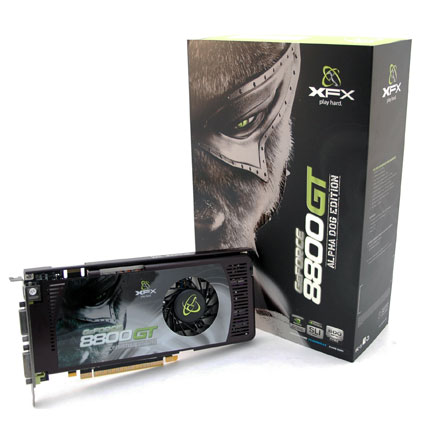
The Alpha Dog Edition XXX we have runs at a slightly overclocked 650MHz core clock, 1.6GHz shader clock and with 256MB of GDDR3 running at a 1.6GHz data rate. That's an 8% higher core clock, 7% higher shader clock and 11% lower memory clock than a standard 512MB 8800 GT. The card is available and considerably cheaper than the $300 512MB cards floating around, so we'll look at whether losing 256MB of frame buffer matters all that much later on in the review.
The Test
Note that the results from this article can't be compared to those from our 8800 GT and Radeon HD 3800 articles, we're using different hardware, updated drivers and in some cases updated benchmarks to keep up with the latest game patches.
We aren't going to recap some of the basic performance comparisons we did in the two aforementioned reviews, so if you want to know how the 8800 GT stacks up against older cards or how the older GTSes perform, be sure to consult those articles.
Our test platform for this article is as follows:
| Test Setup | |
| CPU | Intel Core 2 Extreme QX6850 |
| Motherboard | ASUS P5E3 Deluxe |
| Video Cards | AMD Radeon HD 3870 AMD Radeon HD 3850 NVIDIA GeForce 8800 Ultra NVIDIA GeForce 8800 GTS 512 NVIDIA GeForce 8800 GT (512MB & 256MB) |
| Video Drivers | AMD: Catalyst 7.11 NVIDIA: 169.12 |
| Hard Drive | Seagate 7200.9 300GB 8MB 7200RPM |
| RAM | 4x1GB Corsair XMS3 DDR3-1066 7-7-7-20 |
| Operating System | Windows Vista Ultimate 32-bit |
8800 GTS 512 vs. 8800 Ultra
The 8800 Ultra was expensive when it was released in May of this year, and honestly not much has changed. The 8800 GTS 512 outclasses the Ultra in just about every category, the exception being raw memory bandwidth. The question we're looking to answer first is whether there's still a need for the 8800 Ultra, or if this sub-$400 card makes 2007's most expensive single GPU obsolete.
Quake Wars shows the two cards performing virtually the same, the Ultra starts to pull away at 2560 x 1600:
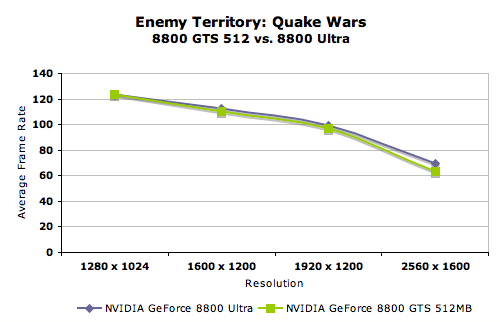
Turning on AA gives us a clear difference between the two, at 2560 x 1600 the Ultra has a 47% performance advantage over the 8800 GTS 512:
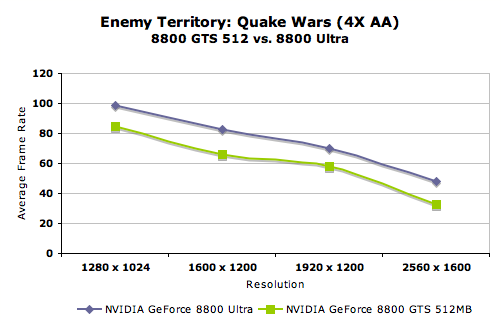
We see the same story with World in Conflict, there's no performance difference between the two cards until we turn on AA:
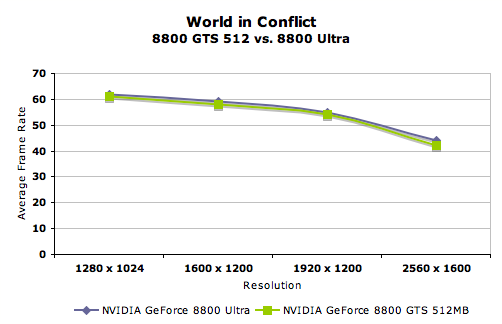
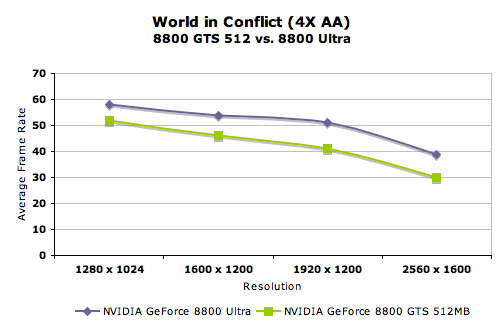
Lighter titles such as Half Life 2 and Oblivion (yep, Oblivion is a lighter title now) show the two cards as being equal:
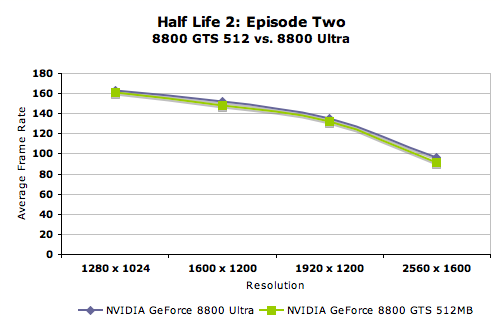
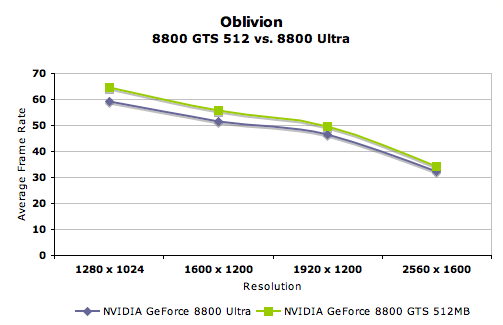
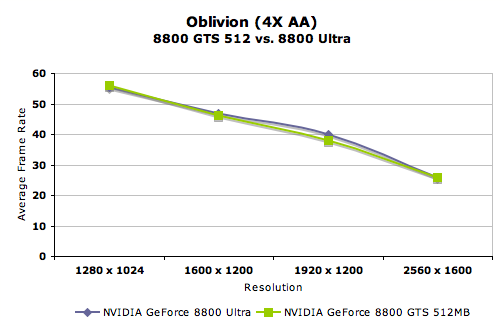
The added pixel pushing power of the 8800 GTS 512 give it the advantage in our Oblivion test, but much of that advantage gets erased when we turn on 4X AA.
Looking at newer titles like Crysis, Call of Duty 4 and Unreal Tournament 3 we see 8800 Ultra levels of performance from the $350 8800 GTS 512. Not bad.
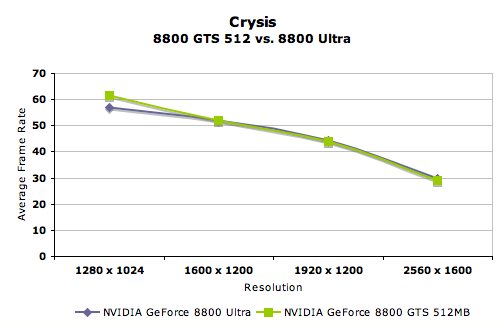
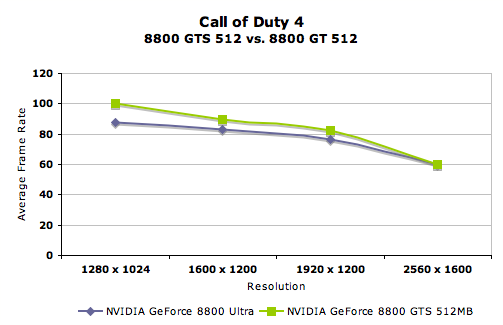
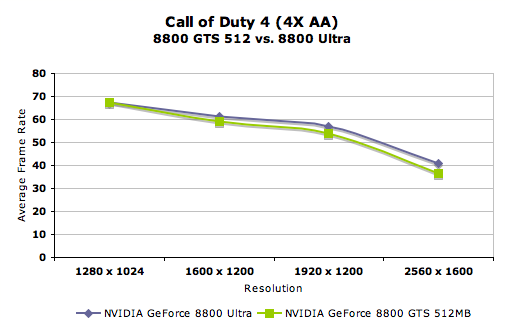
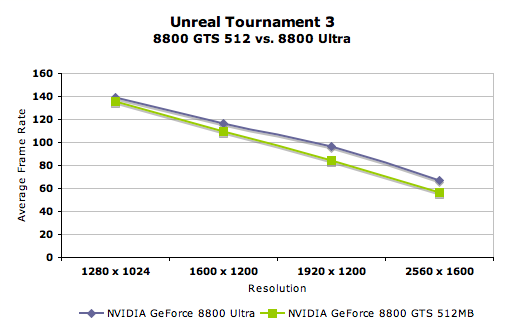
Overall, the 8800 GTS 512 is definitely competitive with the 8800 Ultra, however there are definitely cases where the raw memory bandwidth of the Ultra's 384-bit memory bus just can't be beat. If you've got an 8800 Ultra, feel threatened, but there's no need to worry about replacing your card. And if you're somehow choosing between the two, the GTS 512 comes close enough overall and for cheap enough that you can afford to skip the Ultra...or at least buy two GTS 512s.
8800 GTS 512 vs. 8800 GT
Despite being hardly available, the 8800 GT (512MB) is still a crowd favorite. It's fast, and even at $300 - $350 it's a good card, albeit not nearly as attractive as if you could buy it for $250. It's safe to say that the 8800 GTS 512 will retail for at least $50 more than the 512MB 8800 GT, but what will that $50 buy you?
The 8800 GTS 512 has 24% more shader processing power than the GT but just under 8% more memory bandwidth. Where the 8800 GTS 512 needs to really shine in order to distance itself from the GT is in high resolution performance, but it may not have the memory bandwidth to really do so. Let's find out whether or not that's true:
We'll start off with Quake Wars, here we see a healthy 10 - 15% performance advantage at 1600 x 1200 and up:
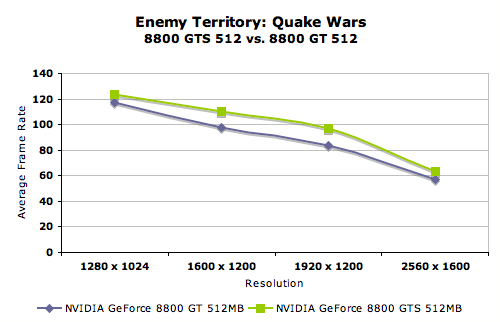
Turning on AA however erases the advantage as limited memory bandwidth becomes the great equalizer:
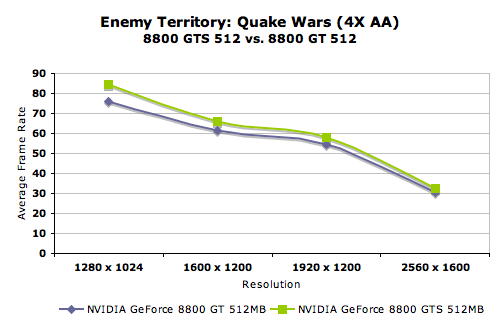
World in Conflict shows a similar but less severe pattern:
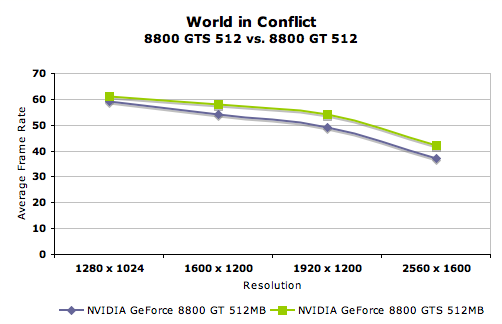
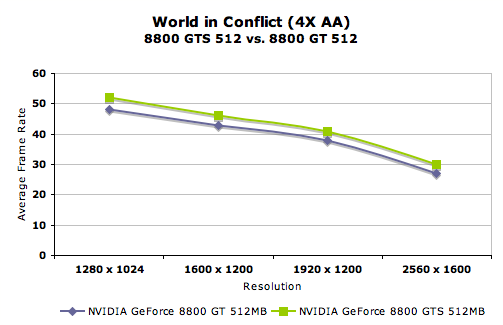
Without AA enabled, the GTS 512 shows a 7% advantage at 1600 x 1200, 10% at 1920 x 1200 and 13.5% at 2560 x 1600. With AA enabled the performance gap shrinks to 7%, 8% and 11%, respectively.
The rest of the titles show similar performance patterns, at higher resolutions the GTS 512 holds a 10 - 15% performance advantage over the 8800 GT. Turn on AA and the advantage drops to 7 - 11%.
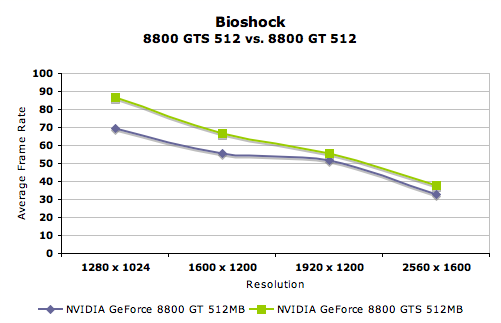
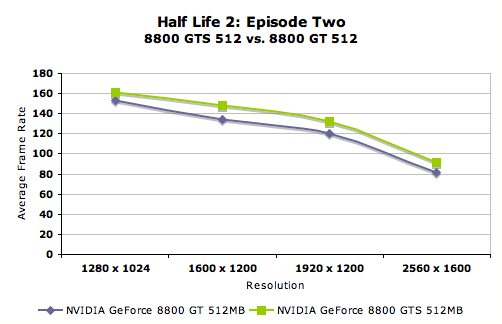
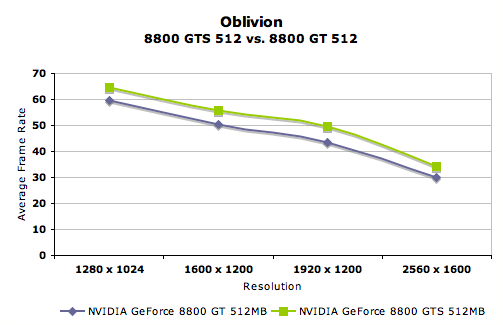
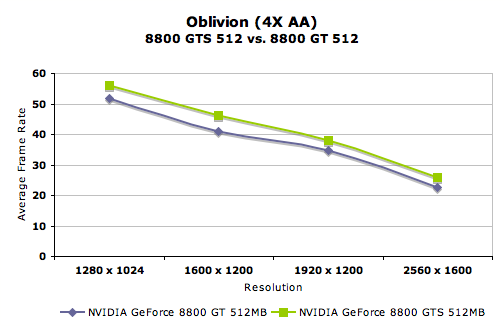
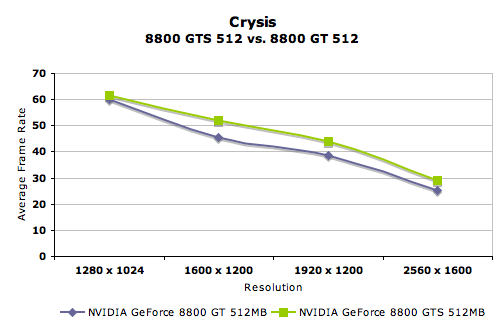

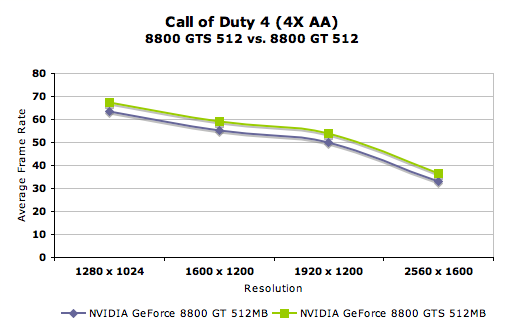
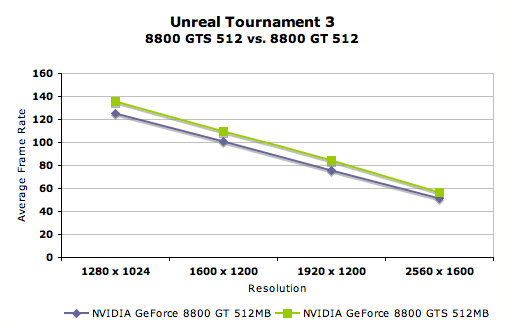
The 8800 GTS 512 looks to be an average of 10% faster than the 8800 GT, is it worth the $50+ premium it'll command? Not really, the 512MB 8800 GT is still the sweet spot. Moving on...
8800 GT 512MB vs. 256MB
When AMD released the Radeon HD 3800 series, NVIDIA responded by saying that a cheaper 256MB version of the 8800 GT would be on its way, priced below $200. NVIDIA delivered on part of its promise, we do have a 256MB 8800 GT in hand but it's not a sub-$200 card. The 8800 GT 256 we have is the Alpha Dog Edition XXX from XFX, priced at $229 not including a $10 mail in rebate. That's not too far off the mark but it's still not less than $200.
The XFX card we have runs at a 650MHz core clock but only has a 1.6GHz memory data rate. The reference 512MB card runs at 600MHz core/1.8GHz memory.
Quake Wars starts off showing us a trend we'll see quite often with the 256MB 8800 GT, it performs virtually identically to its 512MB brother until after 1600 x 1200 then there's a sharp drop off:
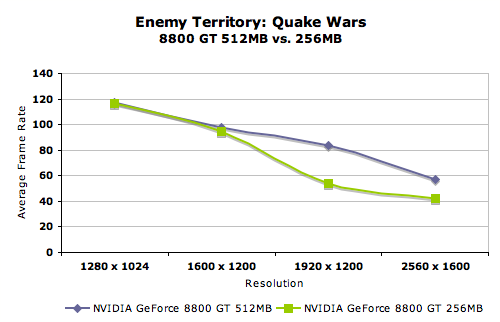
The performance hit isn't as pronounced when you turn on AA, instead you get a 10 - 20% hit across the board:
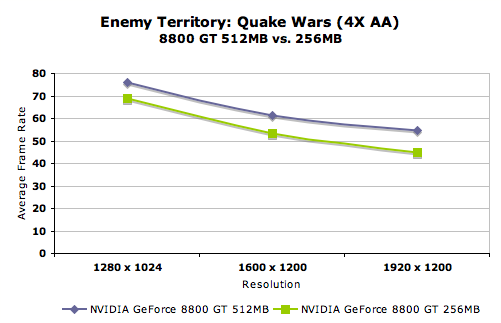
Bioshock shows the same thing, competitive performance up to 1600 x 1200 but at 1920 x 1200 the 512MB card has a 16% advantage, and a 60% advantage at 2560 x 1600. It is worth noting that neither card is really playable at 2560 x 1600 in Bioshock.
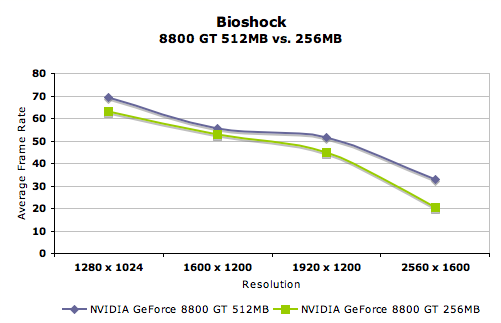
World in Conflict moves the choke point up to 1600 x 1200; the two cards behave similarly at 1280 x 1024, but the 512MB 8800 GT holds on to a 20% minimum advantage at 1600 x 1200 and grows it to 40% at 2560 x 1600.
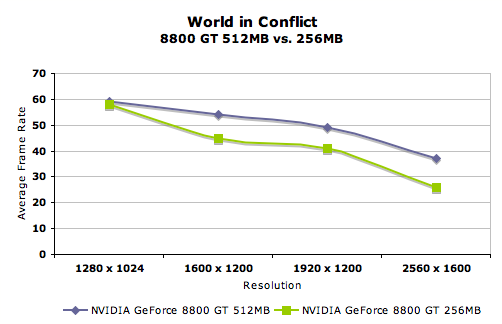
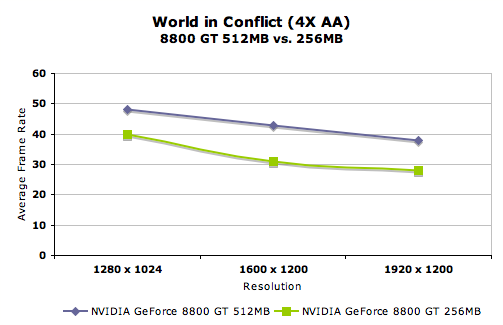
Older titles like Half Life 2 and Oblivion show absolutely no difference between the two cards, showing us that this current wave of games and most likely all those to follow require larger than 256MB frame buffers. While 256MB could cut it in the Half Life 2 and Oblivion days, the same just isn't true any more.
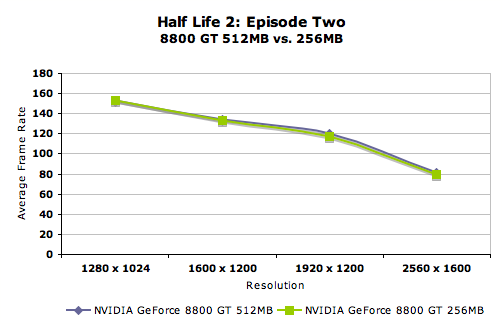
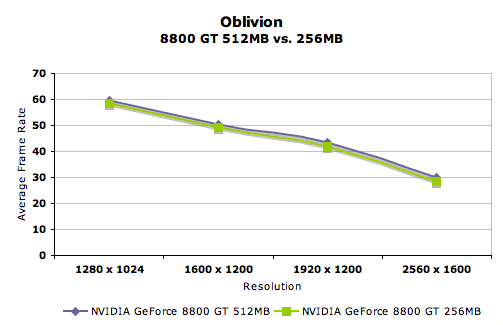
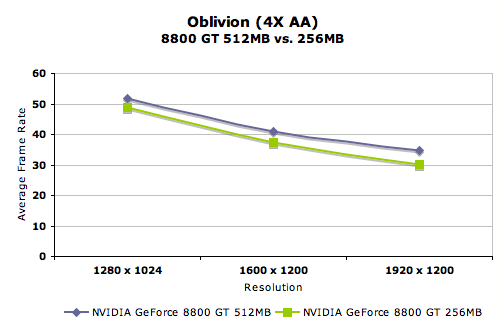
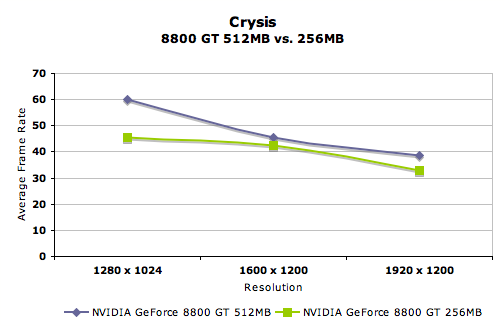
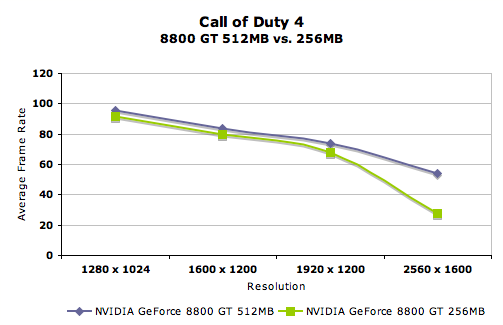
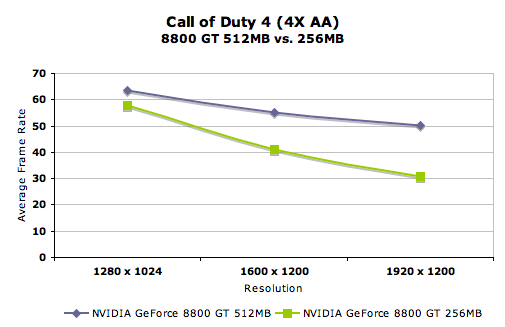
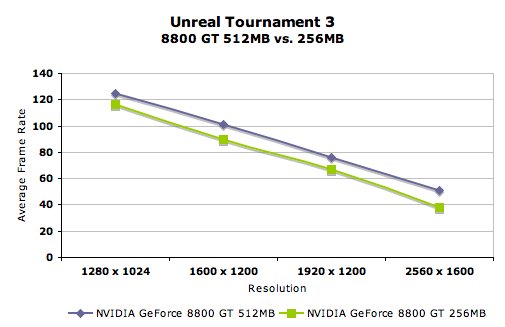
What we have here is an 8800 Ultra that's $50 more for not much more gain, and a 256MB 8800 GT that's at least $70 cheaper for a lot less performance. If you plan on keeping this card for any length of time, it looks like 512MB is the way to go. Frame buffer demands of modern games are only going to increase, and it looks like what we're seeing here today is an indication that the transition to 512MB as a minimum for high end gaming performance is officially underway. The 768MB memory sizes of the 8800 GTX are still not totally required, but 512MB looks like the sweet spot.
8800 GT 256 vs. Radeon HD 3870/3850
With the 8800 GT 256 priced at $219 - $229 it finds its way smack in the middle of the Radeon HD 3850 at $179 and the Radeon HD 3870 at around $250.
To make our job extremely difficult, the 8800 GT 256 manages to find itself performing in between the two Radeon HD 3800 cards in almost all benchmarks with a couple exceptions.
Performance in Crysis continues to be an issue for the Radeon HD series, which AMD insists is just an issue with driver optimizations. The same problem exists in Oblivion, but there's no excuse for a lack of driver optimizations there, Oblivion has been out for a very long time now.
Then there are games like World in Conflict where the 8800 GT 256 performs like a Radeon HD 3850 or worse.
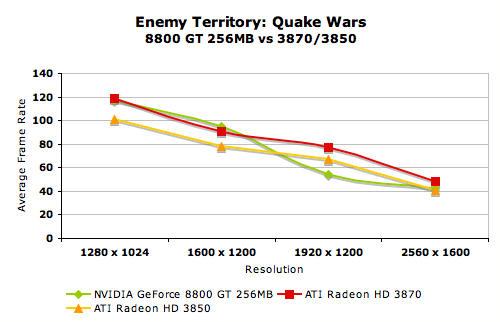
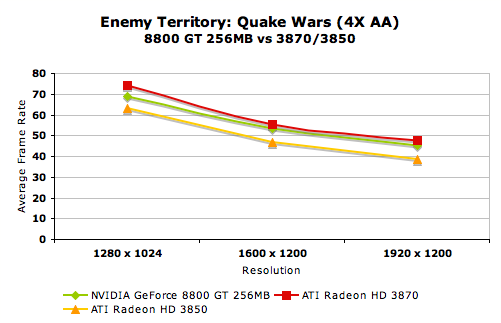
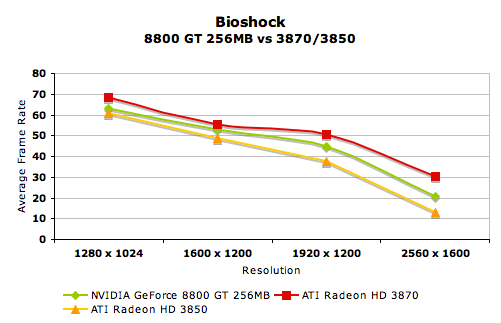
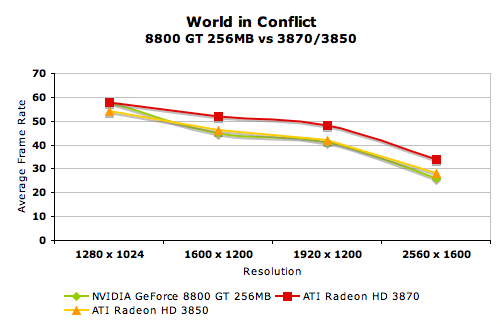
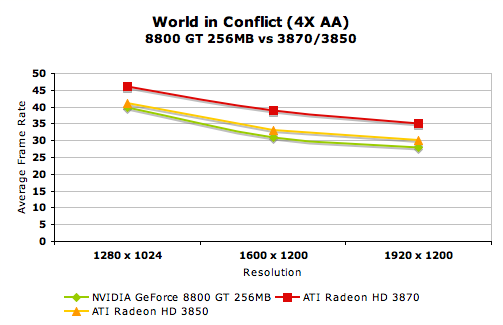
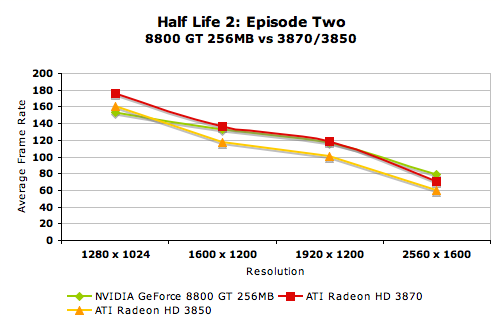
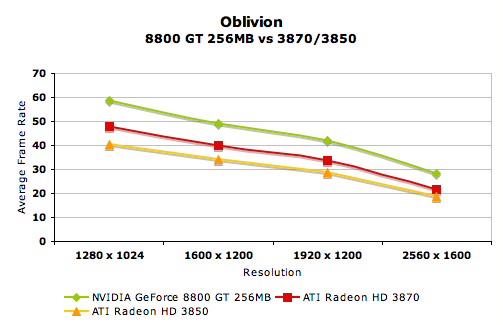
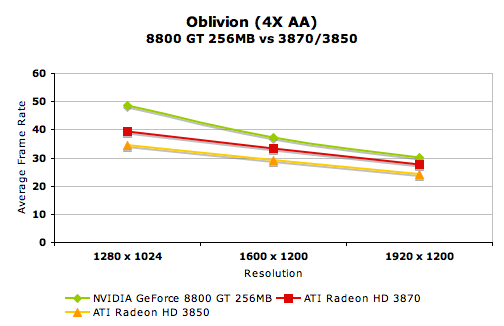
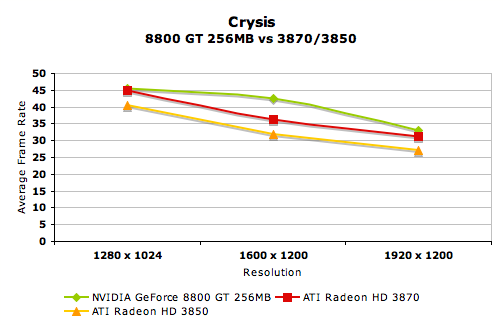
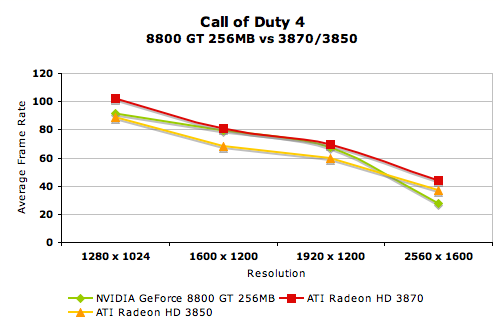
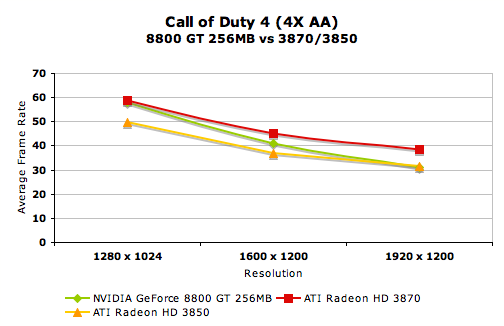
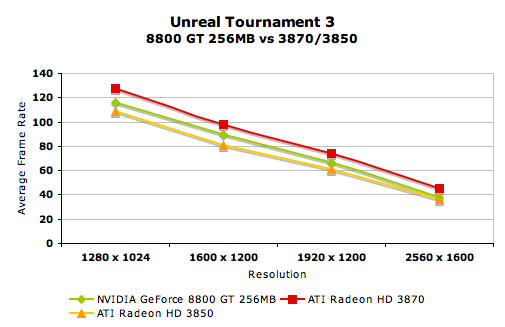
Overall, it seems like the 256MB 8800 GT can justify its price. It's cheaper than the Radeon HD 3870, but performs slower in most cases, and more expensive than the 3850 but is faster. The problem here is that the Radeon HD 3870, at $250 isn't that much more expensive, and comes equipped with twice as much memory. If AMD could bring Crysis performance on par with NVIDIA's then it'd be an easy recommendation, but instead we're left with these weird caveats.
The Radeon HD 3870 gets the nod from us here because it's not much more expensive than the 256MB 8800 GT, you get twice the frame buffer and better performance in almost all scenarios. Crysis performance is a big deal however, and the 256MB 8800 GT is a bit cheaper, so if you want a slightly more affordable alternative to the Radeon HD 3870 but don't want to step down to the 3850 then it may not be a bad option.
Power Consumption
As expected, overall power consumption is significantly reduced over the G80 based 8800 Ultra. The 65nm 8800 GTS 512 offers much better performance per watt than its predecessor thanks to the basics of Moore's Law:
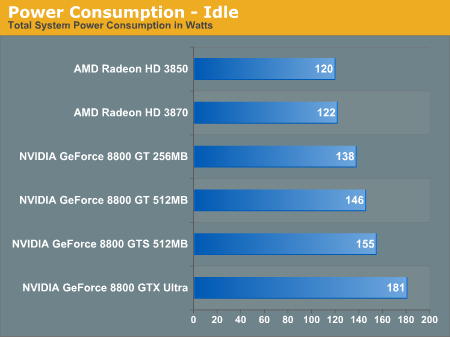
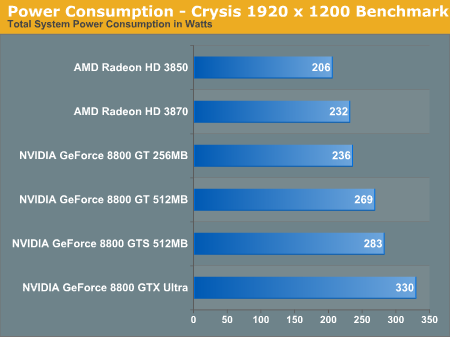
Bar Charts for All
We've had requests for bar charts with all of the cards in them, so without further ado we have the data you've already been presented reformatted into our standard bar graphs. Enjoy:
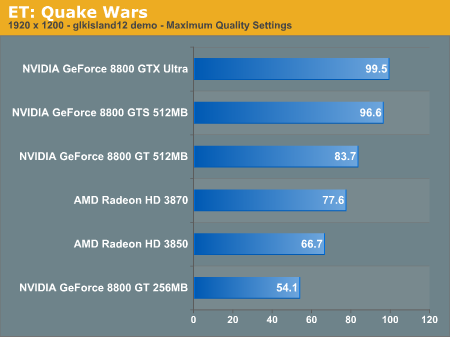
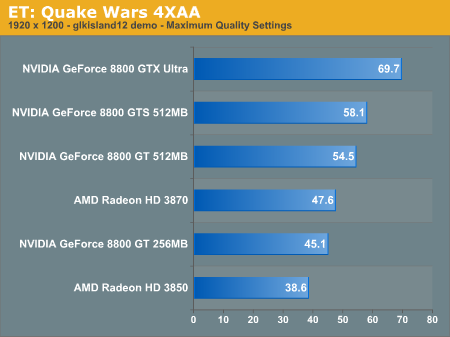
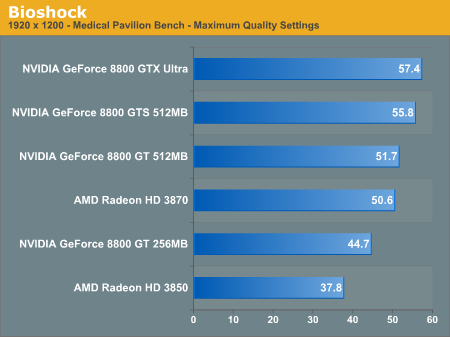
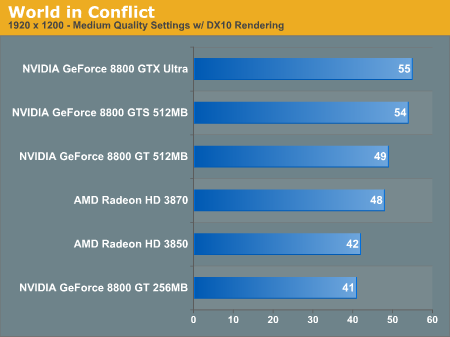
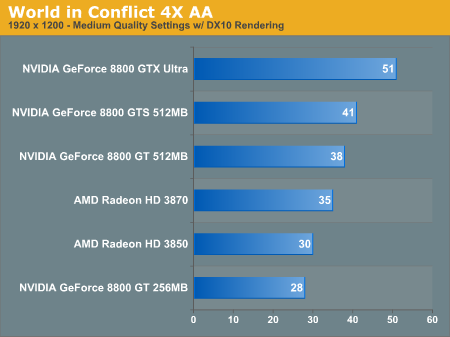
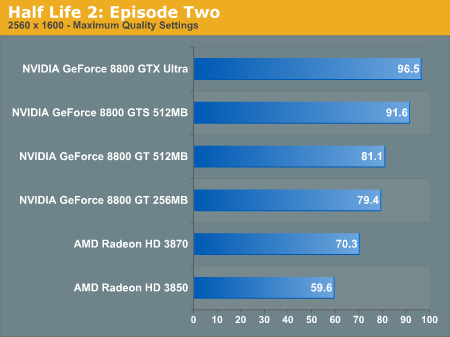
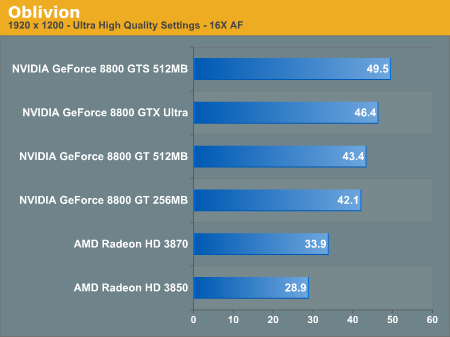
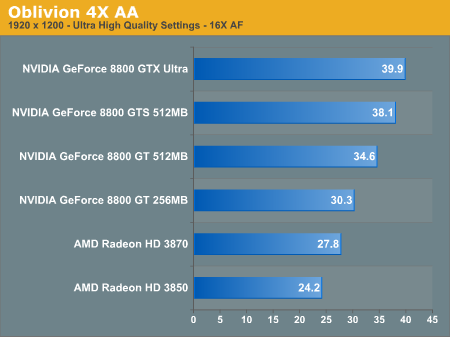
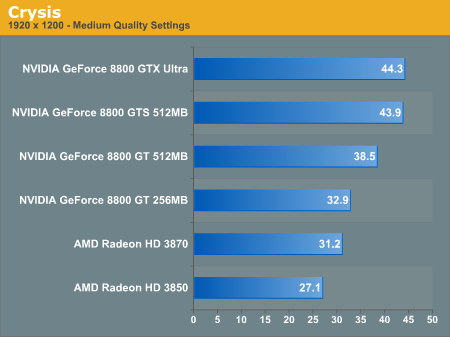
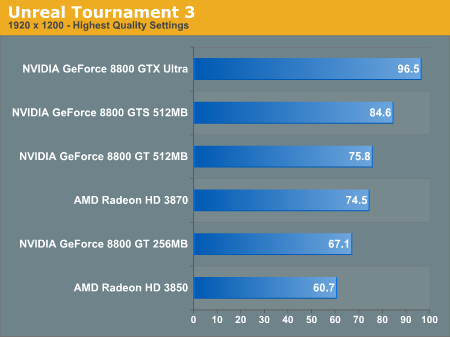
Final Words
I don't think we've ever had so many competitive graphics cards available in $50 increments of one another. Starting at $179 with the Radeon HD 3850 and now going up to just under $400 with the GeForce 8800 GTS 512, if you have a very specific budget there are plenty of options for a faster graphics card these days.
Honestly, despite the great value from cards like the 8800 GT and the Radeon HD 3800 series, there's still a need for even higher performance GPUs. If you looked at our bar graphs, there are some games where we're still forced to run at Medium Quality settings. Titles like World in Conflict and Crysis simply can't be run at high resolution with full detail settings on even the 8800 GTS 512, at least at reasonable frame rates. We regularly see this seesaw between software and hardware in the 3D gaming space; sometimes our hardware outpaces the software, and other times the software is far ahead of the hardware.
Here's the thing: remember how the 8800 GT came out and made most of NVIDIA's productline obsolete? Well, there's bound to be a G92 based successor to the 8800 Ultra, despite it being faster than the new GTS 512 it's still fundamentally built on old technology and is overdue for a refresh. If you absolutely must have the highest performance and the 8800 GTS 512 won't satisfy you, don't splurge on an 8800 Ultra, we figure you'll regret it within a matter of months. NVIDIA can't go that long without a super expensive graphics card.
Getting back to reality for a moment, what do we think about the 8800 GTS 512 as an overall buy? It's around 10 - 15% faster than the 8800 GT, with a 16% higher price tag (at least). Honestly, in our opinion, GTS 512 just isn't worth the price premium over the 8800 GT 512MB. There's significantly more shader processing power but with barely any more memory bandwidth, this isn't a card that's really any more suited for high resolution/AA performance than the 8800 GT.
It looks like our verdict still stands: if you want one of the best gaming cards on the market today, the 8800 GT 512MB is still our choice. It's more expensive than we'd like, but the 256MB version is a little too slow, and the GTS 512 isn't fast enough. The 8800 GT 512MB is just right.







